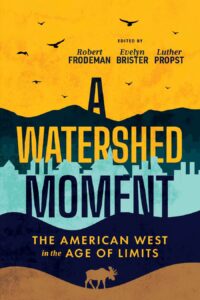From ranchettes to wreckreation
Essay collection seeks solutions, limits to growth in the New West
Essay collection seeks solutions, limits to growth in the New West
One of my first jobs in journalism was at Rocky Mountain Magazine, a gloriously glossy monthly bent on chronicling and celebrating emerging lifestyles, businesses and attitudes in the eight mountain states, from Arizona to Montana—what urban planners, economists and others were beginning to call the New West.
The New West, our experts predicted, would be a much hipper, more environmentally conscious place than the “old” West. Oil rigs, mining operations and other noxious, boom-bust industries would be replaced by solar and wind farms. Corporate ranches would be transformed into sophisticated resort areas and “smart growth” communities, and outdoor industry entrepreneurs would serve as stewards of the backcountry and evangelists of responsible tourism. Much of the toxic mythology about the West, which had led to the wholesale destruction of Indigenous peoples, wildlife and natural resources in the name of manifest destiny and rugged individualism, would be jettisoned, but its magnificent vistas would remain.
The magazine didn’t last long. Ironically, it was a casualty of a downturn in the antiquated oil-and-gas business, which emptied out office buildings in downtown Denver in the 1980s. It was the same old story: boom, then bust.
Unbridled optimism about the new direction of the New West didn’t last, either. Myths are hard to shake, and many people still believe the region is the land of opportunity, or at least of fresh starts. The population of the Rocky Mountain states has almost quadrupled in the past 60 years, from less than seven million residents in 1960 to more than 25 million people today. The relentless growth has strained water supplies, disrupted ecosystems, fostered sprawl and raised housing costs so much that many workers in desirable mountain towns can no longer afford to live there. Add to that the existential threats posed by drought, wildfire and other disasters linked to climate change, as well as the need to protect popular trails and wilderness areas from being loved to death, and the challenges facing the region seem almost insurmountable.

Available for order at your local independent bookseller or at bookshop.org
A new collection of essays, A Watershed Moment: The American West in the Age of Limits attempts to confront many of the most pressing problems and propose solutions—or at least a path forward. The contributors are planners, public officials, scientists, policy experts and other close observers of New West tensions and controversies, but they are each hunkered down in a particular setting, which gives the book a patchwork feel. What works in Telluride to address housing problems, one of the editors points out, may not work in Bozeman. Still, many common themes emerge, such as the need for collaboration among disparate groups. Private landowners, federal and local government, Indigenous tribes and others all need to be at the table if the evolving West is going “to create a society to match its scenery,” as Wallace Stegner put it—a sentiment so hopeful that it’s quoted three times in this collection.
But that goal is at odds with many current economic forces in the region. City planner Shawn Hill describes “an increasingly mobile elite” driving the mania for mega-mansions, ranchettes and second homes in once-remote areas; these elites may have little connection to the local community and little awareness of how their arrival changes things. Jackson Hole, Wyoming, now has the highest per-capita income in the country; but it also has an ever-widening gap between what the average worker earns and the price of housing. As a result, most of its workers have become long-distance commuters, unable to afford the astronomical cost of a place near town.
Across the West, the aftershocks of the pandemic have added to the housing crisis, as well-heeled remote workers figure out that they can live just about anywhere that has good wifi. Short-term rentals contribute to the problem, too; in scenic Sedona, Arizona, which now has more STRs than hotel rooms, “neighborhoods sometimes feel besieged by a revolving door of weekend vacationers who park on the street, party loudly, create more trash than the average homeowner, and make people feel like strangers on their own block,” laments Jennifer Wesselhoff, formerly president of Sedona’s Chamber of Commerce. Town officials are strategizing ways to limit the STRs and build a more community-oriented tourism economy.
Several of the essays deal with intricate conundrums involving public and private lands, including the conflicting “multi-purpose” missions of federal agencies that are supposed to accommodate rising demands for grazing, drilling and recreational opportunities while protecting a dwindling wilderness. There are some useful lessons here in how proper planning and research can develop workarounds for deer trying to migrate across busy highways, or for salmon defying a complex of dams and other obstacles to spawn upstream. The planner-jargon prose can be, at times, as arid as the land it describes, but A Watershed Moment also contains some lively environmental reporting by journalists Jonathan P. Thompson and Todd Wilkinson.
Perhaps the most engaging single piece is by Colorado State University wildlife biologist Stewart W. Breck, who discusses his efforts to help Durango and Aspen residents coexist with black bears, largely through better food storage and disposal. Imagine his mortification at discovering that a bear assault on his Prius in a backcountry parking lot was due to his own carelessness with a single Palisade peach: “There was my car with the driver’s door bent back, the window blown out, bear pawprints all over the front seat, and a peach pit on the driver’s seat.”
Inspiring success stories are interspersed throughout the collection. The reintroduction of beaver has revived riparian areas in Idaho. The sinking water level in Lake Powell has a surprising upside in the emerging flora and fauna in long-submerged areas of Glen Canyon. But many of the West’s gravest problems have no ready fix, given the unrealistic expectations and myth-drenched delusions of many of its residents. People who live in the wildland-urban interface tend to see wildfire as a tolerable risk rather than an inevitable consequence of human incursions and wishful thinking. People whose livelihood depends on promoting and monetizing the scenery are not likely to acknowledge that they are degrading what brought them to the region in the first place. Those who want to preserve what is special about the West, writes Wyoming county commissioner Luther Propst, are fighting “a deeply ingrained societal commitment to perpetual growth.”
That fight continues, but forming workable coalitions takes time—and cooperation from an array of federal and state agencies. One development too recent for this book to address is the return of Donald J. Trump to the White House, amid promises to slash national park budgets, roll back environmental laws, privatize public lands and return to the drill-baby-drill rapacity of the Old West. At best, the looming threat of Trump’s agenda will test the resolve and principles of those who want to see a more sensible society in a more sustainable New West.
Click here for more from Alan Prendergast.

